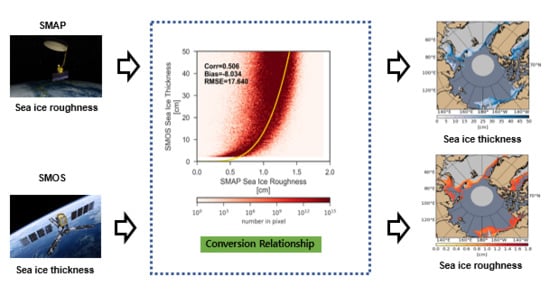Circumpolar Thin Arctic Sea Ice Thickness and Small-Scale Roughness Retrieval Using Soil Moisture and Ocean Salinity and Soil Moisture Active Passive Observations
Abstract
1. Introduction
2. Data
3. Method
3.1. Retrieval of Soil Moisture Active Passive Sea Ice Roughness (SMAP SIR)
3.2. Conversion Relationship between SIR and SIT
3.3. Retrievals of SMAP SIT and SMOS SIR
3.4. Validation of SMAP SIT and SMOS SIR
4. Results
5. Summary and Concluding Remarks
Author Contributions
Funding
Acknowledgments
Conflicts of Interest
References
- Hong, S.; Shin, I. Global trends of sea ice: Small-scale roughness and refractive index. J. Clim. 2010, 23, 4669–4676. [Google Scholar] [CrossRef]
- Johannessen, O.M. Decreasing arctic sea ice mirrors increasing CO2 on decadal time scale. Atmos. Ocean. Sci. Lett. 2008, 1, 51–56. [Google Scholar] [CrossRef]
- Kwok, R.; Rothrock, D.A. Decline in Arctic sea ice thickness from submarine and ICESat records: 1958–2008. Geophys. Res. Lett. 2009, 36, L15501. [Google Scholar] [CrossRef]
- Laxon, S.W.; Giles, K.A.; Ridout, A.L.; Wingham, D.J.; Willatt, R.; Cullen, R.; Kwok, R.; Schweiger, A.; Zhang, J.; Haas, C.; et al. CryoSat-2 estimates of Arctic sea ice thickness and volume. Geophys. Res. Lett. 2013, 40, 732–737. [Google Scholar] [CrossRef]
- Shepherd, A.; Wingham, D.; Wallis, D.; Giles, K.; Laxon, S.W.; Sundal, A.V. Recent loss of floating ice and the consequent sea level contribution. Geophys. Res. Lett. 2010, 37, L13503. [Google Scholar] [CrossRef]
- Stroeve, J.C.; Kattsov, V.; Barrett, A.; Serreze, M.; Pavlova, T.; Holland, M.; Meier, W.N. Trends in Arctic sea ice extent from CMIP5, CMIP3 and observations. Geophys. Res. Lett. 2012, 39, L16502. [Google Scholar] [CrossRef]
- Comiso, J.C.; Cavalieri, D.J.; Markus, T. Sea ice concentration, ice temperature, and snow depth using AMSR-E data. IEEE Trans. Geosci. Remote Sens. 2003, 41, 243–252. [Google Scholar] [CrossRef]
- Hong, S.; Shin, I.; Byun, Y.; Seo, H.-J.; Kim, Y. Analysis of sea ice surface properties using ASH and Hong approximations in satellite remote sensing. Remote Sens. Lett. 2014, 5, 139–147. [Google Scholar] [CrossRef]
- Gorodetskaya, I.V.; Tremblay, L.B.; Liepert, B.; Cane, M.; Cullather, R.J. The influence of cloud and surface properties on the Arctic Ocean shortwave radiation budget in coupled models. J. Clim. 2008, 21, 866–882. [Google Scholar] [CrossRef]
- Manabe, S.; Stouffer, R.J. Century-scale effects of increased atmospheric CO2 on the ocean-atmosphere system. Nature 1993, 364, 215–218. [Google Scholar] [CrossRef]
- Tjernström, M.; Mauritsen, T. Mesoscale variability in the summer Arctic boundary layer. Bound. Layer Meteorol. 2009, 130, 383–406. [Google Scholar] [CrossRef]
- Gutowski, W.J., Jr. Influence of Arctic wetlands on Arctic atmospheric circulation. J. Clim. 2007, 20, 4243–4254. [Google Scholar] [CrossRef]
- Abbot, D.S.; Tziperman, E. Controls on the activation and strength of a high-latitude convective cloud feedback. J. Atmos. Sci. 2009, 66, 519–529. [Google Scholar] [CrossRef]
- Salminen, M.; Pulliainen, J.; Metsämäki, S.; Kontu, A.; Suokanerva, H. The behavior of snow and snow-free surface reflectance in boreal forests: Implications to the performance of snow covered area monitoring. Remote Sens. Environ. 2009, 113, 907–918. [Google Scholar] [CrossRef]
- Qu, X.; Hall, A. Surface contribution to planetary albedo variability in cryosphere regions. J. Clim. 2005, 18, 5239–5252. [Google Scholar] [CrossRef]
- Simmonds, I.; Burke, C.; Keay, K. Arctic climate change as manifest in cyclone behavior. J. Clim. 2008, 21, 5777–5796. [Google Scholar] [CrossRef]
- Screen, J.A.; Simmonds, I.; Keay, K. Dramatic interannual changes of perennial Arctic sea ice linked to abnormal summer storm activity. J. Geophys. Res. 2011, 116, D15105. [Google Scholar] [CrossRef]
- Screen, J.A.; Deser, C.; Simmonds, I.; Tomas, R. Atmospheric impacts of Arctic sea-ice loss, 1979–2009: Separating forced change from atmospheric internal variability. Clim. Dyn. 2014, 43, 333–344. [Google Scholar] [CrossRef]
- Screen, J.A.; Bracegirdle, T.J.; Simmonds, I. Polar climate change as manifest in atmospheric circulation. Curr. Clim. Chang. Rep. 2018, 4, 383–395. [Google Scholar] [CrossRef]
- Parkinson, C.L.; DiGirolamo, N.E. 2016: New visualizations highlight new information on the contrasting Arctic and Antarctic sea-ice trends since the late 1970s. Remote Sens. Environ. 2016, 183, 198–204. [Google Scholar] [CrossRef]
- Isakov, N.A.; Yakovlev, A.N.; Nikulin, A.E.; Serebryansky, G.Y.; Patrakova, T.A. The NSR Simulation Study Package 3: Potential Cargo Flow Analysis and Economic Evaluation for the Simulation Study (Russian Part); International Northern Sea Route Programme (INSROP Working Paper 139): Lysaker, Norway, 1999; p. 54. [Google Scholar]
- Meier, W.N.; Hovelsrud, G.K.; van Oort, B.E.H.; Key, J.R.; Kovacs, K.M.; Michel, C.; Haas, C.; Granskog, M.A.; Gerland, S.; Perovich, D.K.; et al. Arctic sea ice in transformation: A review of recent observed changes and impacts on biology and human activity. Rev. Geophys. 2014, 51, 185–217. [Google Scholar] [CrossRef]
- Johannessen, O.M.; Alexandrov, V.; Sandven, S.; Pettersson, L.H.; Bobylev, L.; Kloster, L. Remote sensing of sea ice in the Northern Sea Route—Studies and applications; Springer Praxis Books: New York, NY, USA, 2007. [Google Scholar]
- Giles, K.A.; Laxon, S.W.; Ridout, A.L. Circumpolar thinning of Arctic sea ice following the 2007 record ice extent minimum. Geophys. Res. Lett. 2008, 35, L22502. [Google Scholar] [CrossRef]
- Laxon, S.; Peacock, N.; Smith, D. High interannual variability of sea ice thickness in the Arctic region. Nature 2003, 425, 947–950. [Google Scholar] [CrossRef] [PubMed]
- Forsberg, R.; Skourup, H. Arctic Ocean gravity, geoid and sea ice freeboard heights from ICESat and GRACE. Geophys. Res. Lett. 2005, 32, L21502. [Google Scholar] [CrossRef]
- Kwok, R.; Cunningham, G.F.; Wensnahan, M.; Rigor, I.; Zwally, H.J.; Yi, D. Thinning and volume loss of the Arctic Ocean sea ice cover: 2003–2008. J. Geophys. Res. 2009, 114, C07005. [Google Scholar] [CrossRef]
- Cavalieri, D.J.; Gloersen, P.; Campbell, W.J. Determination of sea ice parameters with the NIMBUS 7 SMMR. J. Geophys. Res. 1984, 89, 5355–5369. [Google Scholar] [CrossRef]
- Markus, T.; Cavalieri, D.J. An enhanced NASA team sea ice algorithm. IEEE Trans. Geosci. Remote Sens. 2000, 38, 1387–1398. [Google Scholar] [CrossRef]
- Comiso, J.C. Characteristics of Arctic winter sea ice from satellite multispectral microwave observations. J. Geophys. Res. 1986, 91, 975–994. [Google Scholar] [CrossRef]
- Belchansky, G.I.; Douglas, D.C. Seasonal comparisons of sea ice concentration estimates derived from SSM/I, OKEAN, and RADARSAT data. Remote Sens. Environ. 2002, 81, 67–81. [Google Scholar] [CrossRef]
- Emery, W.J.; Fowler, C.; Maslanik, J. Arctic sea ice concentration from special sensor microwave imager and advanced very high resolution radiometer satellite data. J. Geophys. Res. 1994, 99, 18329–18342. [Google Scholar] [CrossRef]
- Steffen, K.; Schweiger, A. NASA team algorithm for sea ice concentration retrieval from Defense Meteorological Satellite Program Special Sensor Microwave Imager: Comparison with Landsat satellite imagery. J. Geophys. Res. 1991, 96, 21971–21987. [Google Scholar] [CrossRef]
- Maykut, G.A. Energy exchange over young sea-ice in the central Arctic. J. Geophys. Res. 1978, 83, 3646–3658. [Google Scholar] [CrossRef]
- Tian-Kunze, X.; Kaleschke, L.; Maaß, N.; Mäkynen, M.; Serra, N.; Drusch, M.; Krumpen, T. SMOS-derived thin sea ice thickness: Algorithm baseline, product specifications and initial verification. Cryosphere 2014, 8, 997–1018. [Google Scholar] [CrossRef]
- Huntemann, M.; Heygster, G.; Kaleschke, L.; Krumpen, T.; Mäkynen, M.; Drusch, M. Empirical sea ice thickness retrieval during the freeze-up period from SMOS high incident angle observations. Cryosphere 2014, 8, 439–451. [Google Scholar] [CrossRef]
- Heygster, G.; Hendricks, S.; Kaleschke, L.; Maaß, N.; Mills, P.; Stammer, D.; Tonboe, R.T.; Haas, C. L-Band Radiometry for Sea-Ice Applications; Final Report for ESA ESTEC Contract 21130/08/NL/EL; Institute of Environmental Physics, University of Bremen: Bremen, Germany, 2009. [Google Scholar]
- Kaleschke, L.; Maaß, N.; Haas, C.; Hendricks, S.; Heygster, G.; Tonboe, R.T. A sea-ice thickness retrieval model for 1.4 GHz radiometry and application to airborne measurements over low salinity sea-ice. Cryosphere 2010, 4, 583–592. [Google Scholar] [CrossRef]
- Kaleschke, L.; Tian-Kunze, X.; Maaß, N.; Mäkynen, M.; Drusch, M. Sea ice thickness retrieval from SMOS brightness temperatures during the Arctic freeze-up period. Geophys. Res. Lett. 2012, 39, L05501. [Google Scholar] [CrossRef]
- Mätzler, C. Applications of SMOS over terrestrial ice and snow. In Proceedings of the 3rd SMOS Workshop, DLR, Oberpfaffenhofen, Germany, 10–12 December 2001. [Google Scholar]
- Petty, G.W. Physical retrievals of over-ocean rain rate from multichannel microwave imagery. Part I: Theoretical characteristics of normalized polarization and scattering indices. Meteorol. Atmos. Phys. 1994, 54, 79–99. [Google Scholar] [CrossRef]
- Stroeve, J.C.; Markus, T.; Maslanik, J.A.; Cavalieri, D.J.; Gasiewski, A.J.; Heinrichs, J.F.; Holmgren, J.; Perovich, D.K.; Sturm, M. Impact of surface roughness on AMSR-E sea ice products. IEEE Trans. Geosci. Remote Sens. 2006, 44, 3103–3117. [Google Scholar] [CrossRef]
- Wegmüller, U.; Mätzler, C. Rough bare soil reflectivity model. IEEE Trans. Geosci. Remote Sens. 1999, 37, 1391–1395. [Google Scholar] [CrossRef]
- Ulaby, F.T.; Moore, R.K.; Fung, A.E. Microwave Remote Sensing: Active and Passive Vol. II: Radar Remote Sensing and Surface Scattering and Emission Theory; Addison-Wesley: Reading, MA, USA, 1982. [Google Scholar]
- Hong, S. Detection of small-scale roughness and refractive index of sea ice in passive satellite microwave remote sensing. Remote Sens. Environ. 2010, 114, 1136–1140. [Google Scholar] [CrossRef]
- Manninen, A.T. Surface roughness of Baltic sea ice. J. Geophys. Res. 1997, 102, 1119–1139. [Google Scholar] [CrossRef]
- Carlstrom, A. Laser profiler for verification of surface scattering models. In Proceedings of the 11th IEEE Geoscience and Remote Sensing Symposium, Espoo, Finland, 3–6 June 1991. [Google Scholar]
- Kaleschke, L.; Tian-Kunze, X.; Maaß, N.; Beitsch, A.; Wernecke, A.; Miernecki, M.; Müller, G.; Fock, B.H.; Gierisch, A.M.; Schlünzen, K.H.; et al. SMOS sea ice product: Operational application and validation in the Barents Sea marginal ice zone. Remote Sens. Environ. 2016, 180, 264–273. [Google Scholar] [CrossRef]
- Choudhury, B.; Schumugge, J.; Chang, A.; Newton, R. Effect of surface roughness on the microwave emission from soils. J. Geophys. Res. 1979, 84, 5699–5706. [Google Scholar] [CrossRef]
- Wu, S.T.; Fung, A.E. A non coherent model for microwave emissions and backscattering from sea surface. J. Geophys. Res. 1972, 77, 5917–5929. [Google Scholar] [CrossRef]
- Hong, S. Surface roughness and polarization ratio in microwave remote sensing. Int. J. Remote Sens. 2010, 31, 2709–2716. [Google Scholar] [CrossRef]
- Hong, S. Retrieval of refractive index over specular surfaces for remote sensing applications. J. Appl. Remote Sens. 2009, 3, 033560. [Google Scholar] [CrossRef]
- Hong, S. Polarization conversion for specular components of surface reflection. IEEE Geosci. Remote Sens. Lett. 2013, 10, 1469–1472. [Google Scholar] [CrossRef]
- Hechts, E. Optics, 3rd ed.; Addison Wesley Longman: New York, NY, USA, 1998. [Google Scholar]
- Paţilea, C.; Heygster, G.; Huntemann, M.; Spreen, G. Combined SMAP–SMOS thin sea ice thickness retrieval. Cryosphere 2019, 13, 675–691. [Google Scholar] [CrossRef]
- Williams, T.; Korosov, A.; Rampal, P.; Ólason, E. Presentation and evaluation of the Arctic sea ice forecasting system neXtSIM-F. Cryosphere 2019. [Google Scholar] [CrossRef]
- Simmonds, I. Comparing and contrasting the behaviour of Arctic and Antarctic sea ice over the 35-year period 1979–2013. Ann. Glaciol. 2015, 56, 18–28. [Google Scholar] [CrossRef]
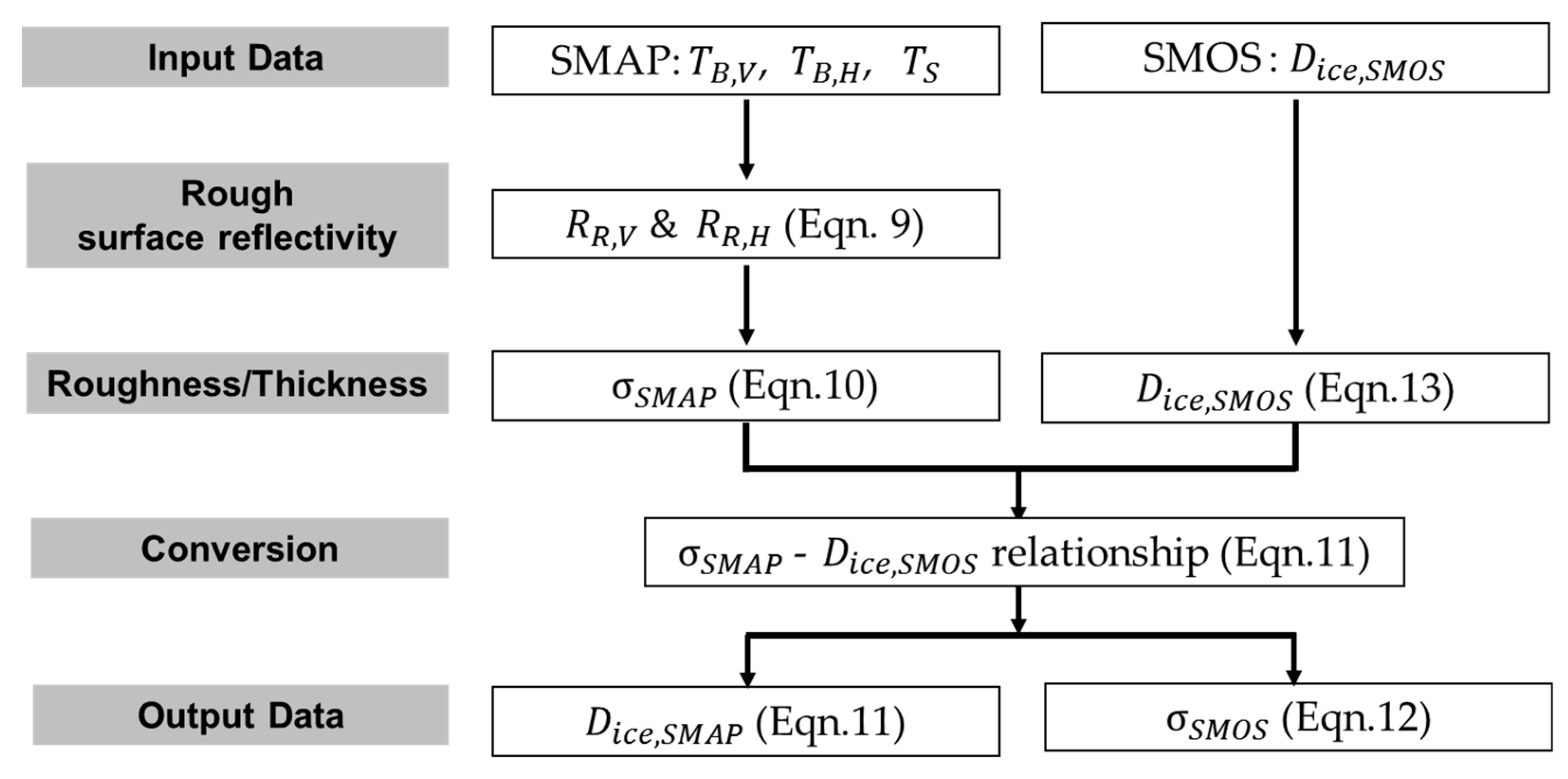
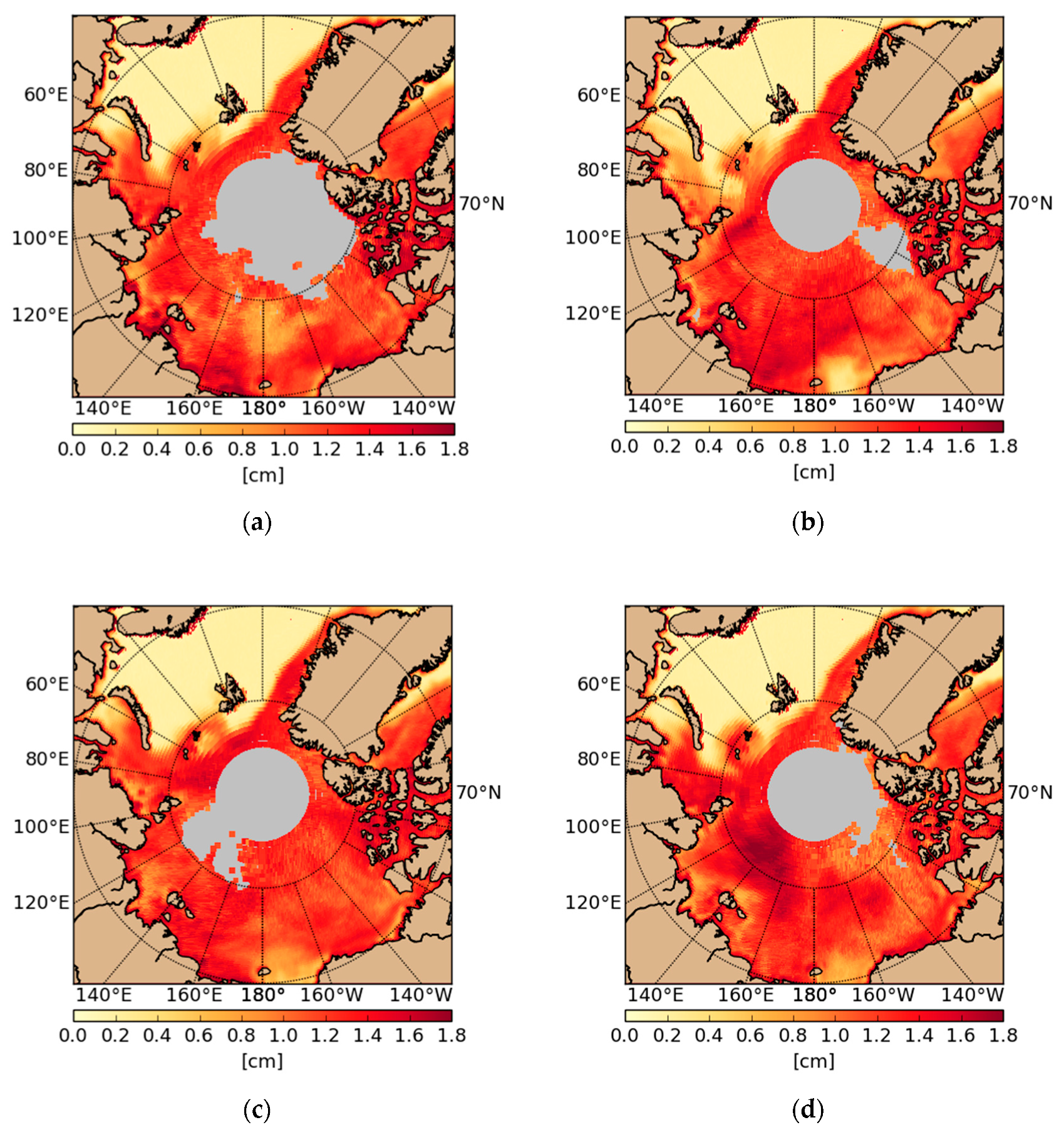
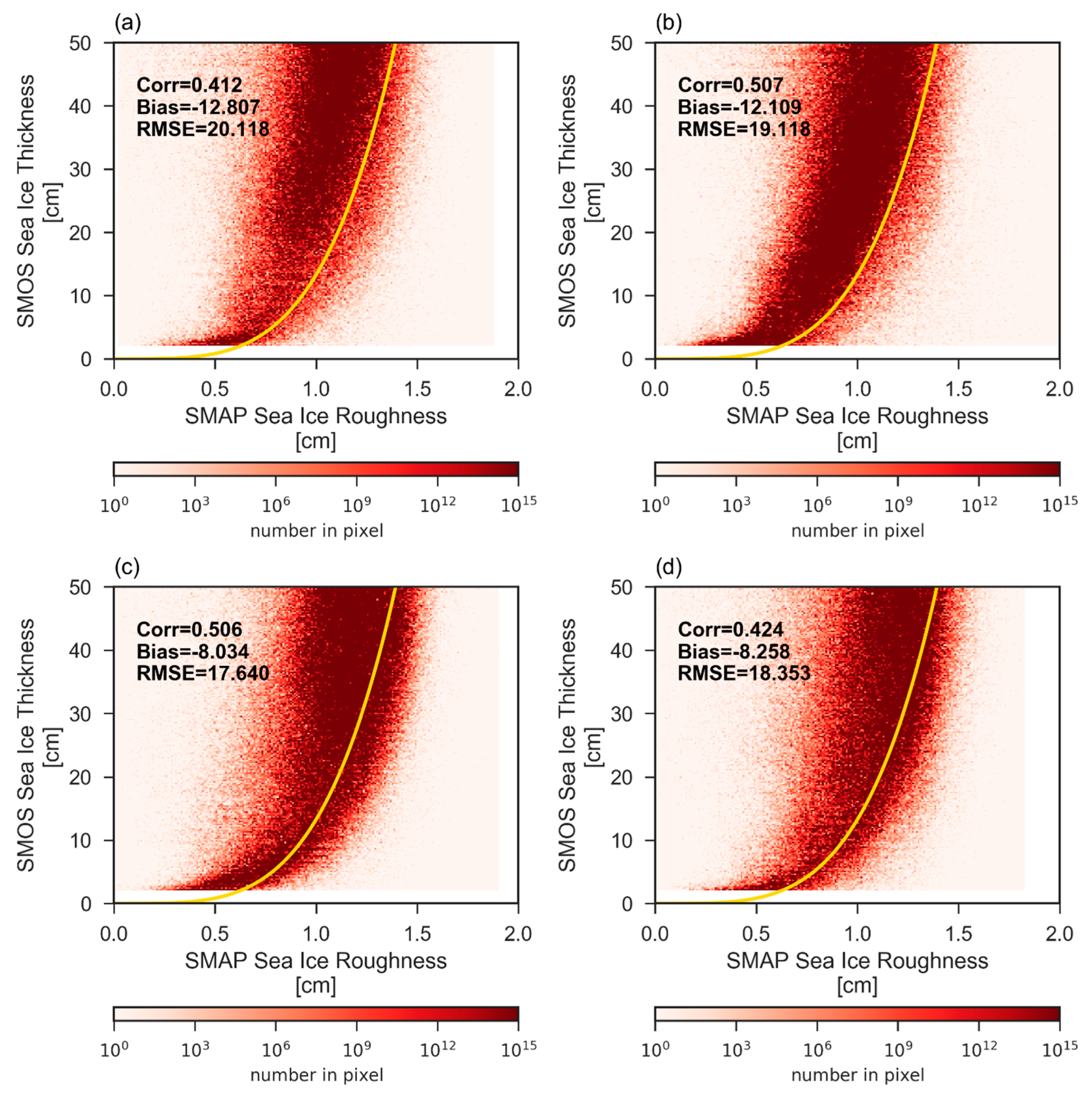
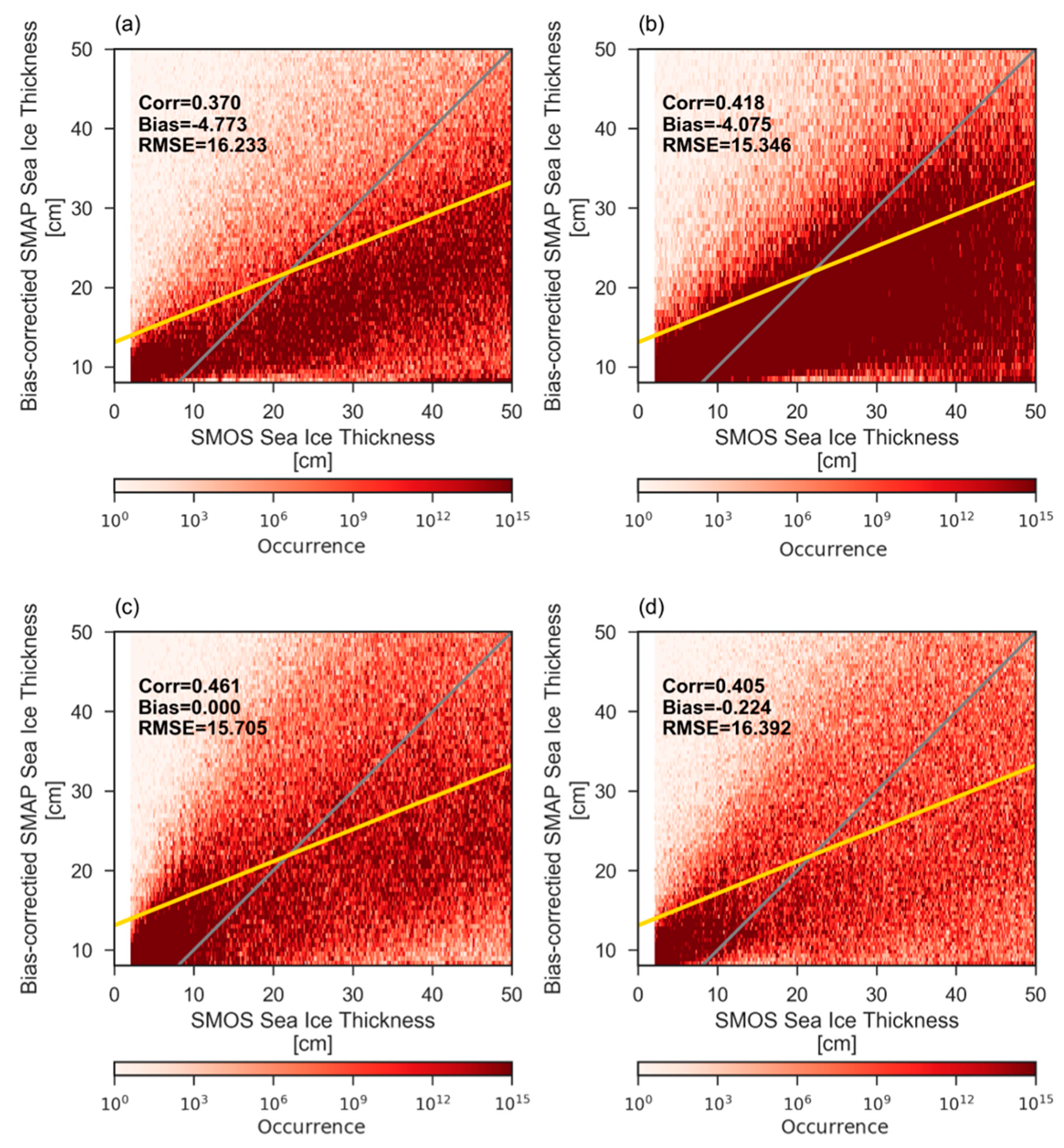
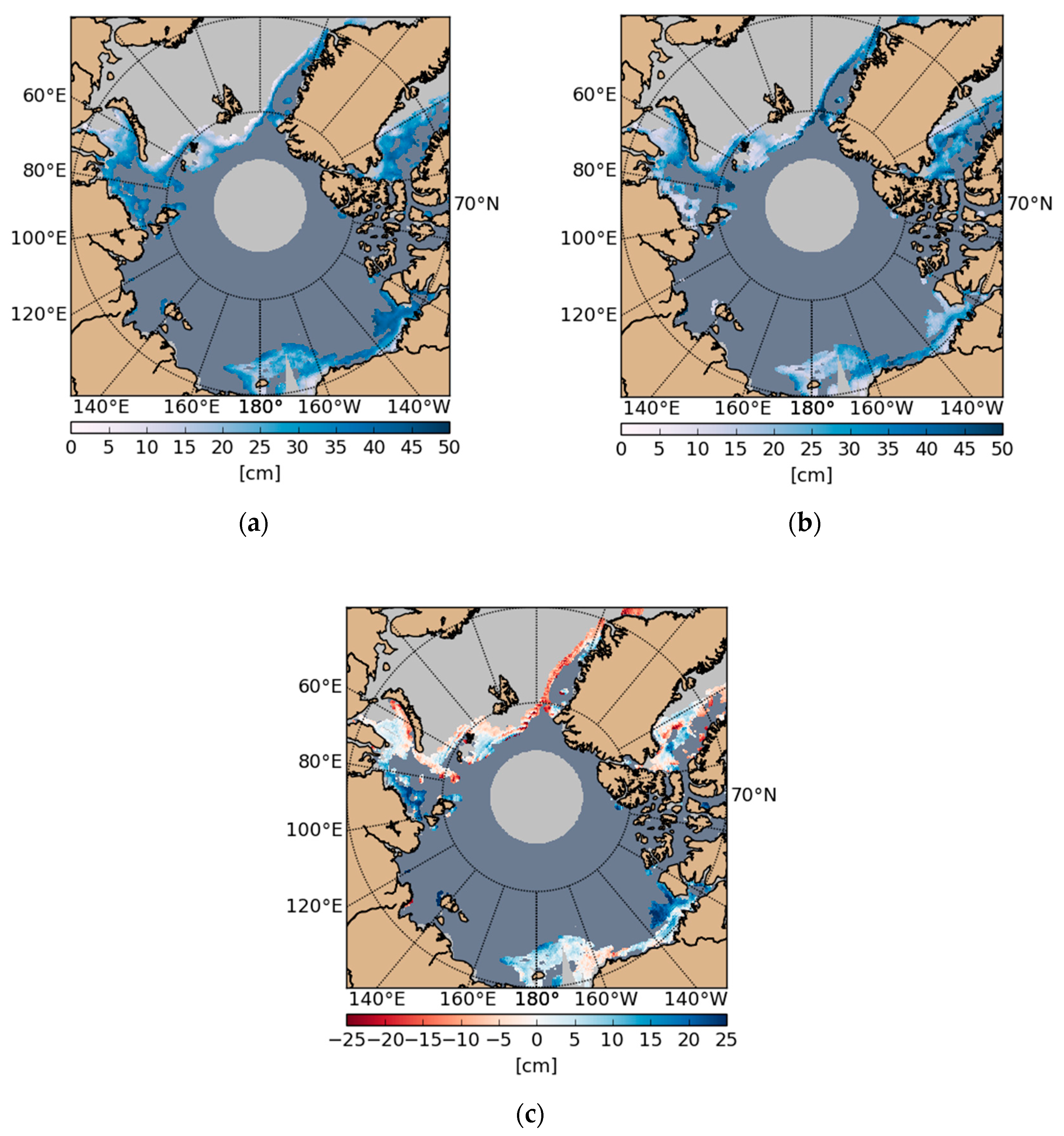
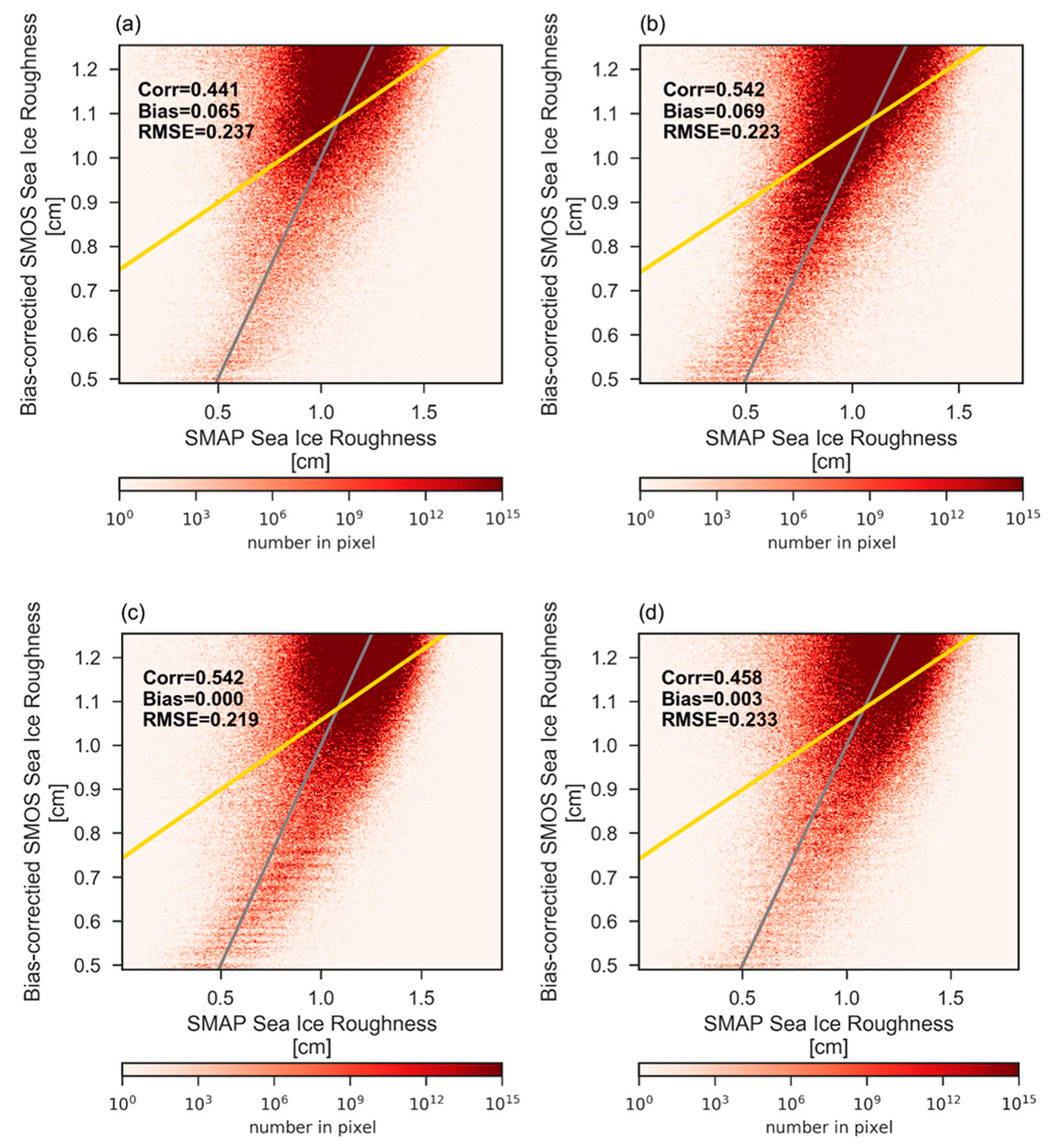
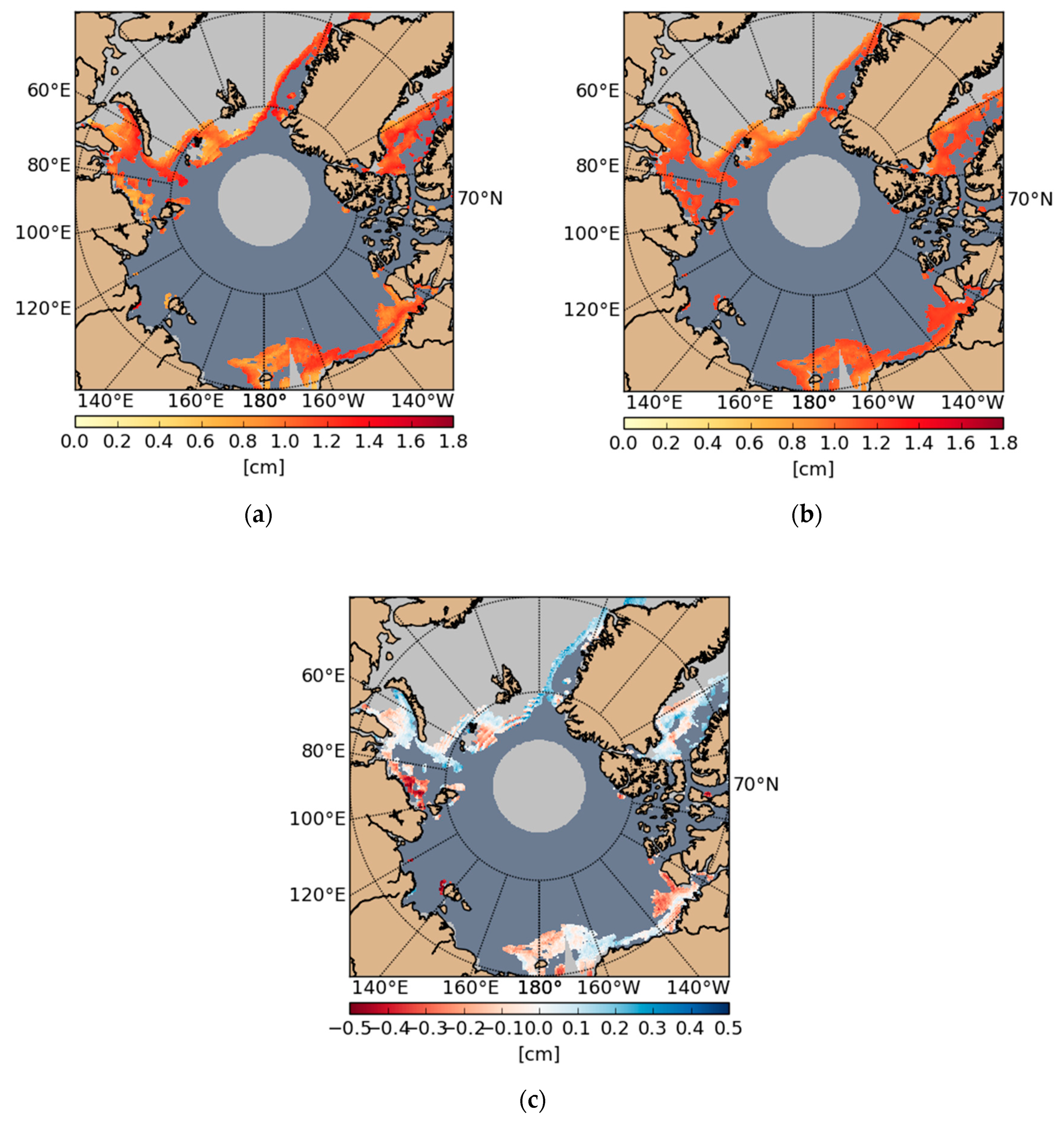
© 2019 by the authors. Licensee MDPI, Basel, Switzerland. This article is an open access article distributed under the terms and conditions of the Creative Commons Attribution (CC BY) license (http://creativecommons.org/licenses/by/4.0/).
Share and Cite
Jo, S.; Kim, H.-C.; Kwon, Y.-J.; Hong, S. Circumpolar Thin Arctic Sea Ice Thickness and Small-Scale Roughness Retrieval Using Soil Moisture and Ocean Salinity and Soil Moisture Active Passive Observations. Remote Sens. 2019, 11, 2835. https://doi.org/10.3390/rs11232835
Jo S, Kim H-C, Kwon Y-J, Hong S. Circumpolar Thin Arctic Sea Ice Thickness and Small-Scale Roughness Retrieval Using Soil Moisture and Ocean Salinity and Soil Moisture Active Passive Observations. Remote Sensing. 2019; 11(23):2835. https://doi.org/10.3390/rs11232835
Chicago/Turabian StyleJo, Suna, Hyun-Cheol Kim, Young-Joo Kwon, and Sungwook Hong. 2019. "Circumpolar Thin Arctic Sea Ice Thickness and Small-Scale Roughness Retrieval Using Soil Moisture and Ocean Salinity and Soil Moisture Active Passive Observations" Remote Sensing 11, no. 23: 2835. https://doi.org/10.3390/rs11232835
APA StyleJo, S., Kim, H.-C., Kwon, Y.-J., & Hong, S. (2019). Circumpolar Thin Arctic Sea Ice Thickness and Small-Scale Roughness Retrieval Using Soil Moisture and Ocean Salinity and Soil Moisture Active Passive Observations. Remote Sensing, 11(23), 2835. https://doi.org/10.3390/rs11232835






